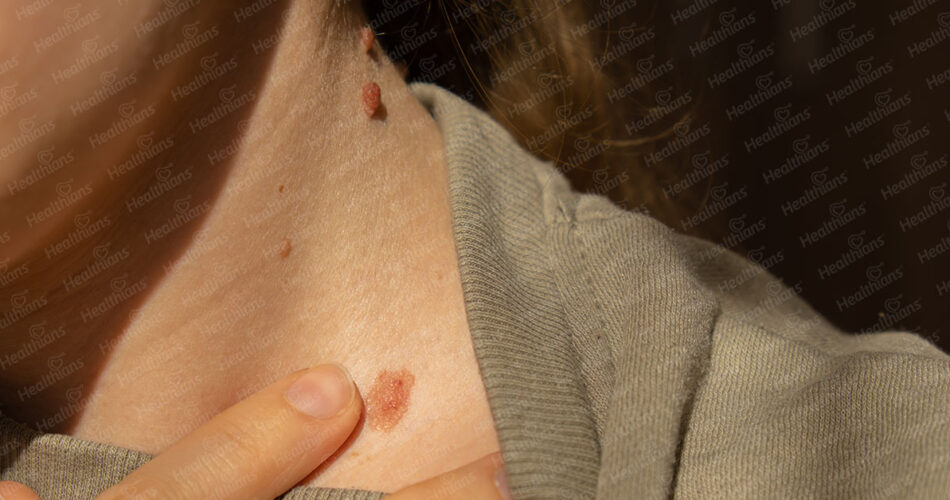Have you ever wondered why sunscreen is now hailed as the holy grail? Not only because it protects us from tanning and hyperpigmentation, but also because it helps prevent skin cancer.
All our life, we have been insisted on staying in nature. But isn’t it ironic how staying out in the sun for long can cause skin cancer? Sun exposure is definitely a cause of most skin cancers, but it is not the only one.
Skin cancer is one of the most common types of cancer worldwide, with millions of cases reported each year. However, the good news is that when detected early, the chances of successful treatment and recovery are significantly higher, as is with any other disease. Recognising the early signs of skin cancer is crucial for early intervention and improved outcomes. Trust us, you don’t need to be a dermatologist to recognise the signs and symptoms. Anyone can do it, with a little guidance.
So, stay tuned because in this blog, we will not only be exploring the various types of skin cancer, and their early warning signs, but the importance of regular self-examinations and professional dermatological checks.
Understanding the types of skin cancer
First things first, it’s important to know the various types of skin cancer so they can be recognised.
Basal Cell Carcinoma (BCC):
BCC is the most common type of skin cancer (80% of all skin cancer cases)
It typically appears on sun-exposed areas of the skin, such as the face, neck, and hands.
BCC often appears as a pearly or waxy bump, a flat, flesh-coloured or brown scar-like area, or a red, irritated patch of skin.
Squamous Cell Carcinoma (SCC):
SCC is the second most common type of skin cancer, accounting for about 20% of cases.
It usually occurs in areas exposed to the sun, such as the face, ears, neck, and back of the hands.
SCC may appear as a firm, red nodule, a flat, scaly, or crusted lesion, or a sore that heals and reopens.
Melanoma:
Melanoma is less common but more aggressive than BCC and SCC.
It can develop anywhere on the skin and, in some cases, in areas with minimal sun exposure.
Early signs of melanoma often include a new or changing mole with irregular borders, asymmetry, multiple colours, or a diameter larger than a pencil eraser.
Recognising early warning signs
Changes in moles:
The ABCDE rule is a useful guideline for evaluating moles:
Asymmetry:
One half is unlike the other half.
Border:
Irregular, blurred, or jagged edges.
Colour:
Uneven colouration, with various shades of brown, black, or even red and white.
Diameter:
Moles larger than 6mm (about the size of a pencil eraser).
Evolving:
Any changes in size, shape, colour, or elevation.
Unusual skin growth:
Be mindful of any new growth on the skin or existing growths that change in size, shape, or colour.
Pay attention to the texture and characteristics of these growths, such as redness, scaliness, or oozing.
Persistent sores:
Open sores that do not heal, or that heal and then reappear, may be a sign of skin cancer.
These sores can be itchy or painful and often bleed.
Skin changes:
Observe any skin changes that are persistent and unusual, such as changes in colour, texture, or sensation.
Be particularly cautious about skin that feels tender, itchy, or painful.
Family and personal history:
A family history of skin cancer can increase your risk. Individuals with fair skin, light eyes, and a history of sunburns are also at higher risk. Personal history of skin cancer increases the likelihood of developing more skin cancer in the future.
The importance of self-examinations
Regular self-examinations are a vital part of early skin cancer detection. Here’s how to perform a thorough self-examination:
Choose a well-lit area:
Find a well-lit room with a full-length mirror.
Examine your entire body:
Start from your head and work your way down, systematically checking your scalp, face, neck, chest, abdomen, arms, hands, legs, feet, and between your toes. You may need help of a second person.
Use a hand mirror:
A hand mirror can help you inspect hard-to-see areas like your back, buttocks, and the back of your neck.
Pay attention to your moles:
Keep an eye on moles and freckles, particularly if you notice any changes. Remember the ABCDE rule for moles.
Note any abnormalities:
If you find any growth, sore, or skin change that concerns you, make a note of it and monitor it over time. If it persists or worsens, consult a dermatologist.
Professional skin checks:
While self-examinations are essential, it’s equally important to schedule regular check-ups with a dermatologist, especially if you have a higher risk of skin cancer. A dermatologist can conduct a thorough examination of your skin, including areas you may not be able to see yourself. They have the expertise to identify subtle or early signs of skin cancer that might be missed during self-examinations.
Closing thoughts
Recognising the early signs of skin cancer is crucial for early diagnosis and successful treatment. Skin cancer is highly curable when detected in its early stages, so being vigilant about changes in your skin and moles can make a significant difference. Remember to protect your skin from excessive sun exposure by wearing sunscreen, and protective clothing, and avoiding peak sun hours.
If you notice any suspicious changes or have a family history of skin cancer, don’t hesitate to consult a dermatologist for a professional evaluation. By taking these steps, you can help safeguard your skin and overall health.




